THE INTERNET OF THINGS:
MAPPING THE VALUE
BEYOND THE HYPE
JUNE 2015
EXECUTIVE SUMMARY
�
In the 25 years since its founding, the McKinsey Global Institute (MGI) has sought to develop
a deeper understanding of the evolving global economy. As the business and economics
research arm of McKinsey & Company, MGI aims to provide leaders in commercial,
public, and social sectors with the facts and insights on which to base management and
policy decisions.
MGI research combines the disciplines of economics and management, employing the
analytical tools of economics with the insights of business leaders. Our “micro-to-macro”
methodology examines microeconomic industry trends to better understand the broad
macroeconomic forces affecting business strategy and public policy. MGI’s in-depth reports
have covered more than 20 countries and 30 industries.
Current research focuses on six themes: productivity and growth, natural resources, labor
markets, the evolution of global financial markets, the economic impact of technology and
innovation, and urbanization. Recent reports have assessed global flows; the economies of
Brazil, Mexico, Nigeria, and Japan; China’s digital transformation; India’s path from poverty
to empowerment; affordable housing; and the effects of global debt.
MGI is led by three McKinsey & Company directors: Richard Dobbs, James Manyika, and
Jonathan Woetzel. Michael Chui, Susan Lund, and Jaana Remes serve as MGI partners.
Project teams are led by the MGI partners and a group of senior fellows, and include
consultants from McKinsey offices around the world. MGI teams draw on McKinsey
partners and experts. Leading economists, including Nobel laureates, serve as MGI
advisers. The partners of McKinsey & Company fund MGI’s research; it is not commissioned
by any business, government, or other institution. For further information about MGI and to
download reports, please visit www.mckinsey.com/mgi.
McKinsey Telecommunications, Media, and High Technology Practice
The McKinsey Telecommunications, Media, and High Technology (TMT) Practice was
established to better address the convergence and synergies in these three sectors.
The TMT Practice serves clients around the world in all areas of the TMT industry. The
Practice has deep functional expertise in capability-building and transformation, product
development, operations, network technology, IT purchasing, and supply chain, as well
as customer lifecycle management, pricing, branding, distribution, and sales. TMT has
developed perspectives on how new business models and disruptive technologies influence
these industries.
McKinsey Business Technology Office
The Business Technology Office (BTO) serves clients in all sectors on top technology
issues facing their executives, helping them understand the long-term technological forces
impacting their businesses. BTO develops IT strategies that are tightly aligned to business
goals, uses technology to digitize business processes, and designs corresponding
organization and governance approaches. We also optimize our clients’ enterprise
architecture, infrastructure, and applications management.
Copyright © McKinsey & Company 2015
�
THE INTERNET OF THINGS:
MAPPING THE VALUE
BEYOND THE HYPE
JUNE 2015
James Manyika | San Francisco
Michael Chui | San Francisco
Peter Bisson | Stamford
Jonathan Woetzel | Shanghai
Richard Dobbs | London
Jacques Bughin | Brussels
Dan Aharon | New York
�
IN BRIEF
THE INTERNET OF THINGS:
MAPPING THE VALUE
BEYOND THE HYPE
The Internet of Things—digitizing the physical world—has received enormous attention. In
this research, the McKinsey Global Institute set out to look beyond the hype to understand
exactly how IoT technology can create real economic value. Our central finding is that the
hype may actually understate the full potential of the Internet of Things—but that capturing
the maximum benefits will require an understanding of where real value can be created and
successfully addressing a set of systems issues, including interoperability.
Viewing IoT applications through the lens of the physical settings in which these systems
will be deployed creates a broader view of potential benefits and challenges. Rather than
just analyzing IoT uses in vertical industries, we also look at settings, such as cities and
worksites. This shows how various IoT systems can maximize value, particularly when
they interact. We estimate a potential economic impact—including consumer surplus—of
as much as $11.1 trillion per year in 2025 for IoT applications in nine settings.
Interoperability between IoT systems is critically important to capturing maximum value;
on average, interoperability is required for 40 percent of potential value across IoT
applications and by nearly 60 percent in some settings.
Most IoT data are not used currently. For example, only 1 percent of data from an oil rig
with 30,000 sensors is examined. The data that are used today are mostly for anomaly
detection and control, not optimization and prediction, which provide the greatest value.
Business-to-business (B2B) applications can create more value than pure consumer
applications. While consumer applications such as fitness monitors and self-driving cars
attract the most attention and can create significant value, we estimate that B2B uses can
generate nearly 70 percent of potential value enabled by IoT.
There is large potential for IoT in developing economies. Over the next ten years, we
estimate higher potential value for IoT in advanced economies because of higher value per
use. However, nearly 40 percent of value could be generated in developing economies.
Customers will capture most of the benefits. We estimate that the users of IoT (businesses,
other organizations, and consumers) could capture 90 percent of the value that IoT
applications generate. For example, the value of improved health of chronic disease
patients through remote monitoring could be as much as $1.1 trillion per year in 2025.
A dynamic industry is evolving around IoT technology. Like other technology waves,
there are opportunities for both incumbents and new players. Digitization blurs the lines
between technology companies and other types of companies; makers of industrial
machinery, for example, are creating new business models, by using IoT links and data to
offer their products as a service.
To realize the full potential from IoT applications, technology will need to continue to evolve,
providing lower costs and more robust data analytics. In almost all settings, IoT systems raise
questions about data security and privacy. And in most organizations, taking advantage of
the IoT opportunity will require leaders to truly embrace data-driven decision making.
�
Where is the value potential of the Internet of Things?9 settingsTransform business processesPredictive maintenance, better asset utilization, higher productivityOutsideLogistics and navigation$560B−850BHumanHealth and tness$170B−1.6TWorksitesOperations optimization/ health and safety$160B−930BRetail environmentsAutomated checkout$410B−1.2TFactoriesOperations and equipment optimization$1.2T−3.7THomeChore automation and security$200B−350BVehiclesAutonomous vehicles and condition-based maintenance$210B−740BOfficesSecurity and energy$70B−150BCitiesPublic healthand transportation$930B−1.7TEnable new business modelsFor example, remote monitoring enables anything-as-a-serviceTypes of opportunities< 1% of data currently used, mostly for alarms or real-time control; more can be used for optimization and predictiongave us a cross-sector view of a total potential impact of $3.9 trillion–11.1 trillion per year in 2025Interoperability required to capture 40% of total value2X more value from B2B applications than consumerDeveloping: 40% Developed: 60%�
Executive summary: Glasses man
© Getty Images
�
EXECUTIVE SUMMARY
The Internet of Things has the potential to fundamentally shift the way we interact with our
surroundings. The ability to monitor and manage objects in the physical world electronically
makes it possible to bring data-driven decision making to new realms of human activity—to
optimize the performance of systems and processes, save time for people and businesses,
and improve quality of life (see Box E1, “Defining the Internet of Things”). From monitoring
machines on the factory floor to tracking the progress of ships at sea, sensors can help
companies get far more out of their physical assets—improving the performance of
machines, extending their lives, and learning how they could be redesigned to do even
more. With wearable devices and portable monitors, the Internet of Things has the potential
to dramatically improve health outcomes, particularly in the treatment of chronic diseases
such as diabetes that now take an enormous human and economic toll.
Manufacturers, oil and gas companies, and other
businesses have already begun to see the initial
payoff from IoT technologies in their operations.
A great deal has been written about the Internet of Things in the past five years, including by
McKinsey, which began publishing its research on the emerging technology in 2010.1 IoT-
enabled developments such as self-driving cars have captured the popular imagination, and
with fitness bands to monitor physical activity and Internet-connected devices to manage
HVAC systems, appliances, entertainment, and security systems, consumers are getting a
glimpse of what the IoT-enabled future may bring. Manufacturers, oil and gas companies,
and other businesses have already begun to see the initial payoff from IoT technologies in
their operations. And technology suppliers are ramping up IoT businesses and creating
strategies to help customers design, implement, and operate complex systems—and
working to fill the gap between the ability to collect data from the physical world and the
capacity to capture and analyze it in a timely way.
1 See, for example, “The Internet of Things,” McKinsey Quarterly, March 2010, and Disruptive technologies:
Advances that will transform life, business, and the global economy, McKinsey Global Institute, May 2013.
Box E1. Defining the Internet of Things
We define the Internet of Things as sensors and actuators connected by networks to
computing systems. These systems can monitor or manage the health and actions of
connected objects and machines. Connected sensors can also monitor the natural world,
people, and animals.
For the purposes of this research, we exclude systems in which all of the sensors’ primary
purpose is to receive intentional human input, such as smartphone apps where data input
comes primarily through a touchscreen, or other networked computer software where the
sensors consist of the standard keyboard and mouse.
�
We conducted this research to examine in detail how the Internet of Things can create
value, and in the process we have uncovered novel findings about how that value can be
captured by companies, people, and economies. Building on our earlier work, the McKinsey
Global Institute, in collaboration with McKinsey’s Telecommunications, Media, and High
Technology Practice and the McKinsey Business Technology Office, analyzed more
than 150 IoT use cases across the global economy. Using detailed bottom-up economic
modeling, we estimated the economic impact of these applications by the potential benefits
they can generate, including productivity improvements, time savings, and improved asset
utilization, as well as an approximate economic value for reduced disease, accidents, and
deaths. These estimates of potential value are not equivalent to industry revenue or GDP,
because they include value captured by customers and consumers.
An important contribution of this research has been to demonstrate the importance of
analyzing the applications of the Internet of Things in the context of settings—the physical
environments in which these systems are deployed, such as homes, offices, and factories.
A key insight from analyzing the benefits of IoT applications within settings is the critical
contribution made by interoperability among IoT systems. On average, interoperability is
necessary to create 40 percent of the potential value that can be generated by the Internet
of Things in various settings. We also see that making IoT applications interoperable—linking
a patient’s home health monitor to the hospital’s health informatics system, for example—is
a complex systems design challenge that requires coordination on many levels (technology,
capital investment cycles, organizational change, and so forth.
For the applications that we size, we estimate that the Internet of Things has a total potential
economic impact of $3.9 trillion to $11.1 trillion per year in 2025. On the top end, the value
of this impact—including consumer surplus—would be equivalent to about 11 percent of
the world economy in 2025.2 Achieving this level of impact will require certain conditions to
be in place and overcoming technical, organizational, and regulatory hurdles. In particular,
organizations that use IoT technology will need better tools and methods to extract insights
and actionable information from IoT data, most of which are not used today. It will take
time for companies to create systems that can maximize IoT value and, more importantly,
for management innovations, organizational changes, and new business models to
be developed and implemented. This could lead to a new “productivity paradox”—a
lag between investment in technology and productivity gains that can be seen at a
macroeconomic level.3
$11T
Maximum potential
value of sized
applications in
2025
Determining the settings where the Internet of Things will create impact
In reviewing nearly 300 IoT applications, we discovered that using only a conventional
approach to categorizing the potential impact by vertical industry markets—such as
automotive or consumer electronics—made it more difficult to analyze all the ways in
which value could be created. If we look at how IoT technology is creating value from the
perspective of the automaker, for instance, we would see how it improves manufacturing
efficiencies and reduces costs. However, by viewing IoT applications through the lens of
settings, we capture a broader set of effects, particularly those that require the interaction
of IoT systems and often produce the greatest impact. For example, by examining the
cities setting, we discover that not only can sensors in individual vehicles be used to save
2 Based on World Bank projection of $99.5 trillion per year in global GDP in 2025
3 The productivity paradox was observed by economists Robert Solow and Stephen Roach, who in 1987 noted
that despite the widespread adoption of computers to automate office functions, there was no evidence of
their impact on productivity. Subsequent research found problems in how government statistics measured the
impact of computers and a lag between investment in technology and the organizational adjustments required
to realize significant productivity gains. See Erik Brynjolfsson and Lorin M. Hitt, “Beyond the productivity
paradox,” Communications of the ACM, volume 41, issue 8, August 1998. See also US Productivity Growth
1995-2000, McKinsey Global Institute, October 2001.
2
McKinsey Global Institute
Executive summary
�
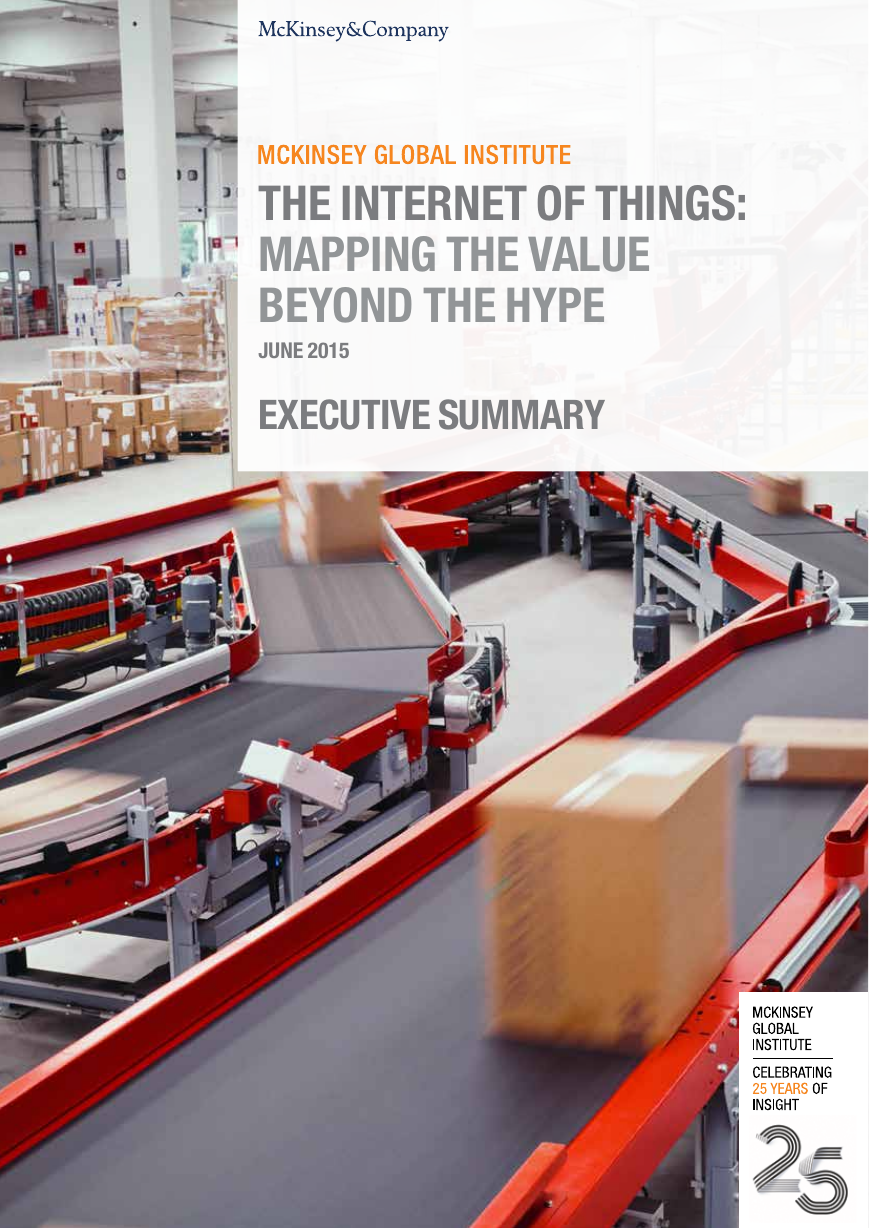
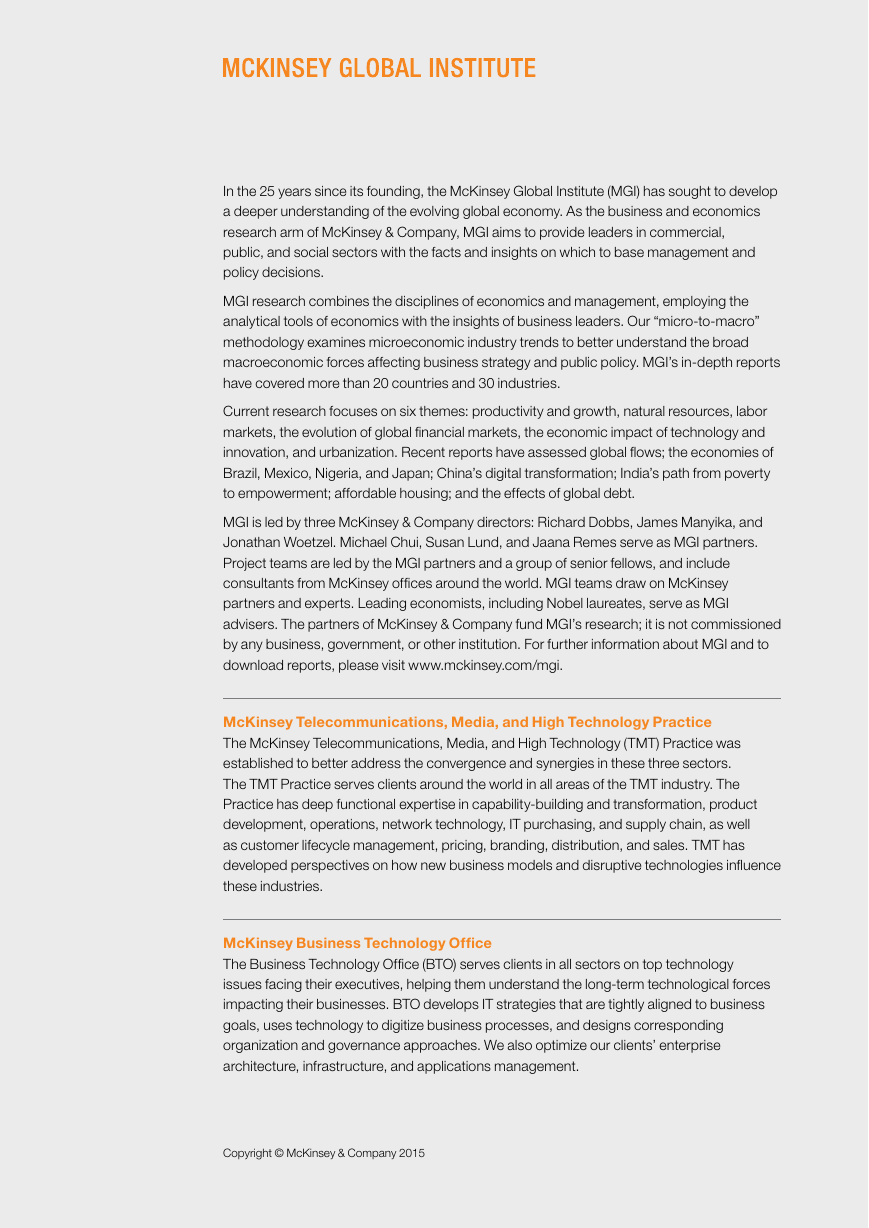
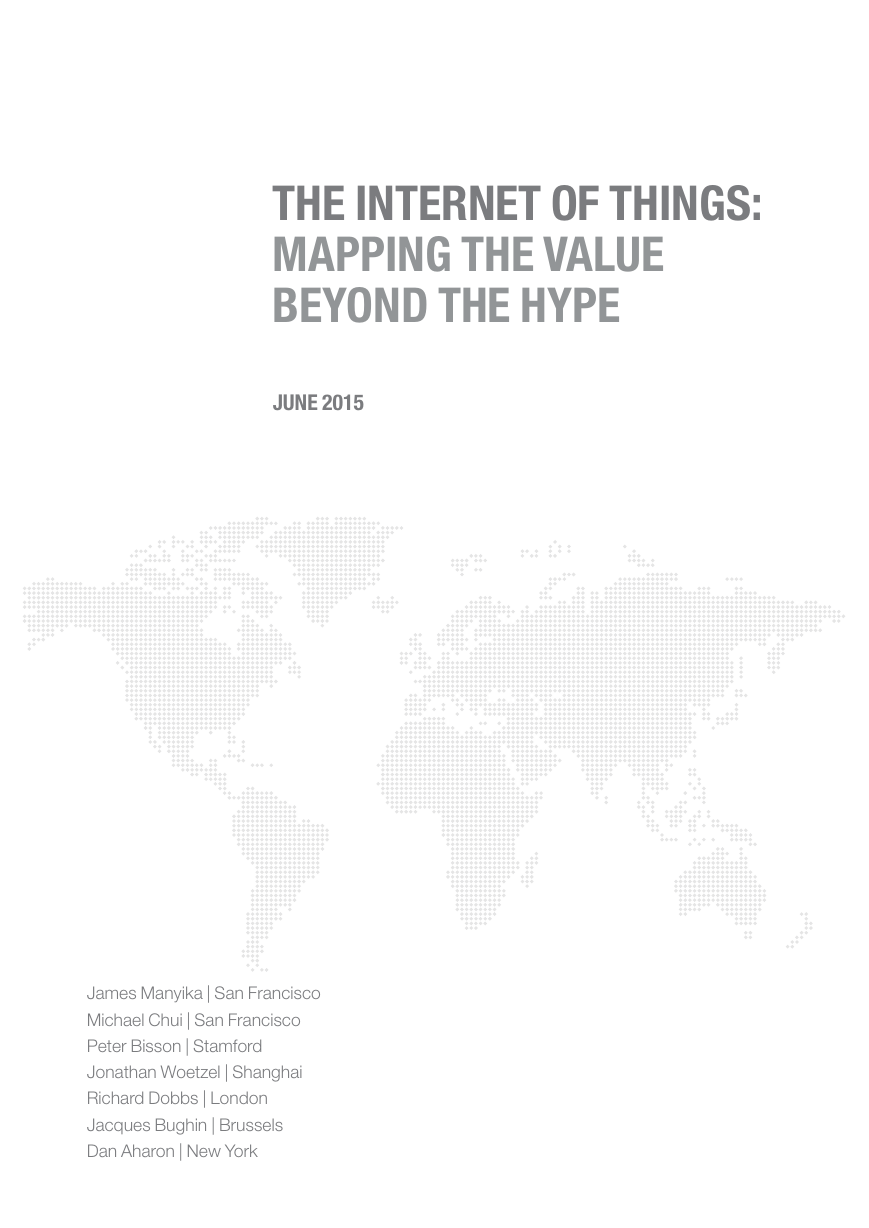
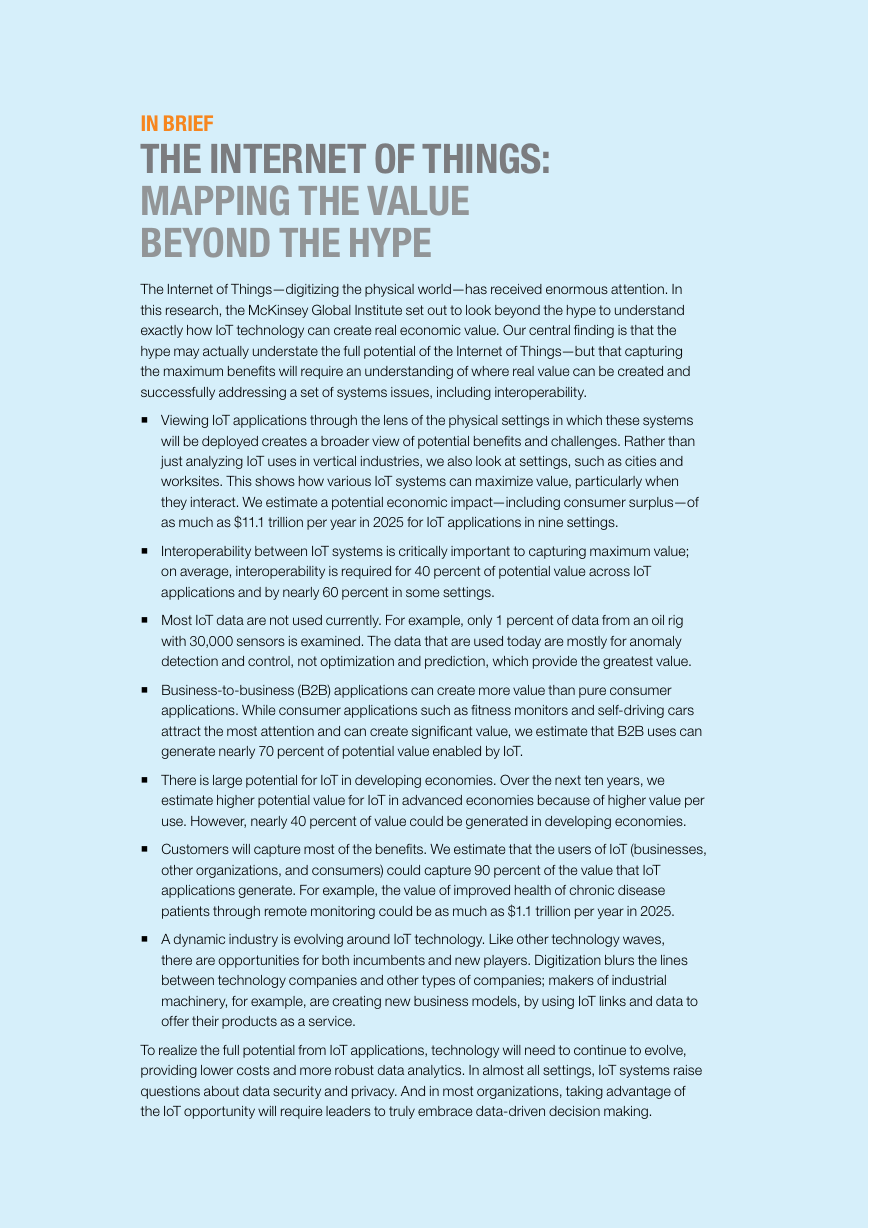


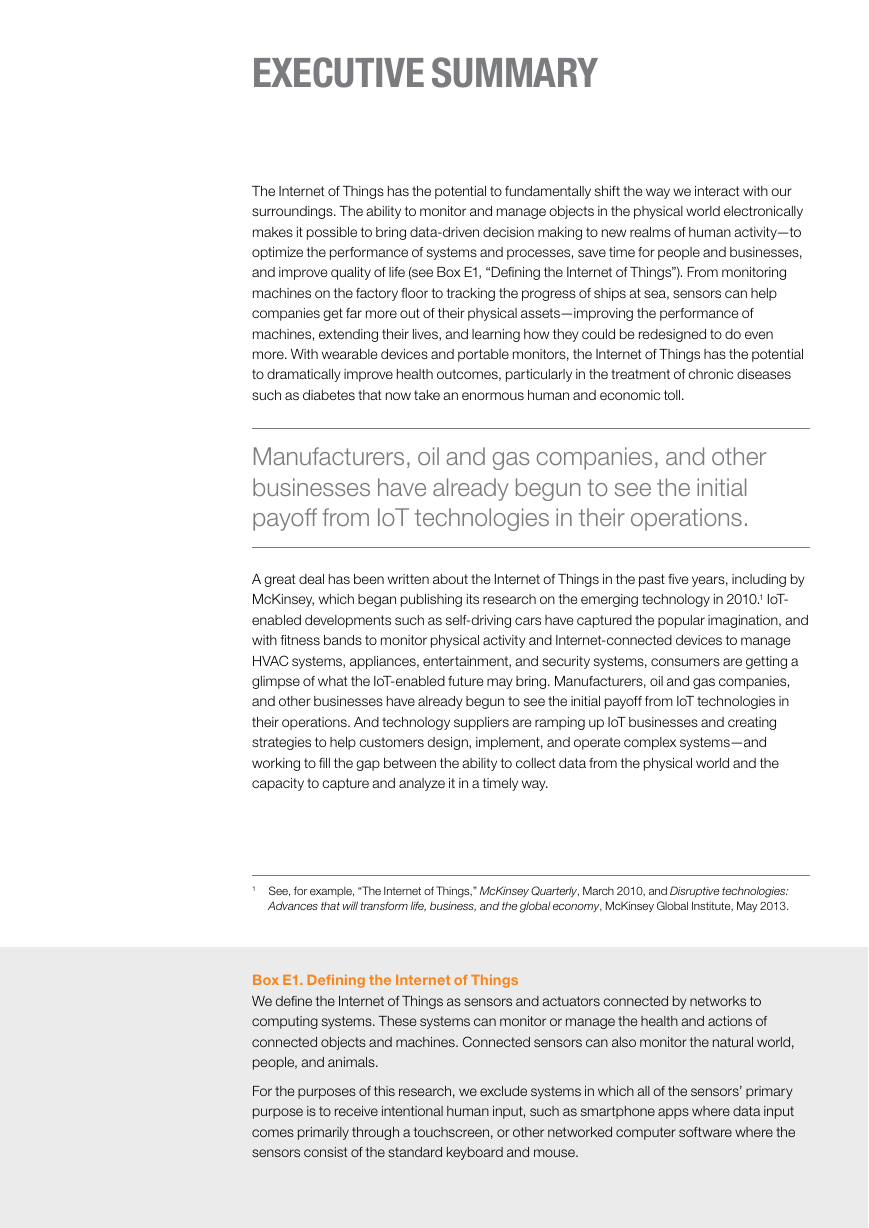
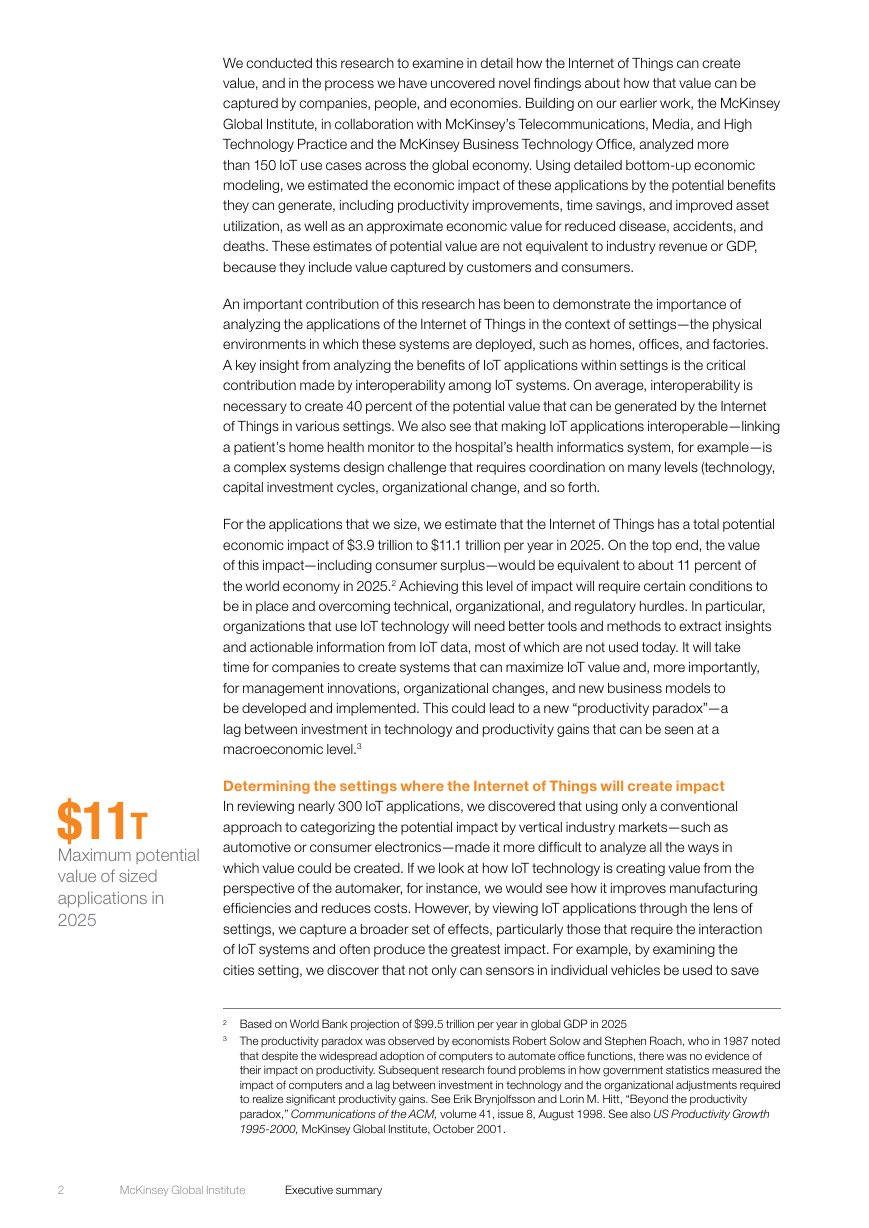








 2023年江西萍乡中考道德与法治真题及答案.doc
2023年江西萍乡中考道德与法治真题及答案.doc 2012年重庆南川中考生物真题及答案.doc
2012年重庆南川中考生物真题及答案.doc 2013年江西师范大学地理学综合及文艺理论基础考研真题.doc
2013年江西师范大学地理学综合及文艺理论基础考研真题.doc 2020年四川甘孜小升初语文真题及答案I卷.doc
2020年四川甘孜小升初语文真题及答案I卷.doc 2020年注册岩土工程师专业基础考试真题及答案.doc
2020年注册岩土工程师专业基础考试真题及答案.doc 2023-2024学年福建省厦门市九年级上学期数学月考试题及答案.doc
2023-2024学年福建省厦门市九年级上学期数学月考试题及答案.doc 2021-2022学年辽宁省沈阳市大东区九年级上学期语文期末试题及答案.doc
2021-2022学年辽宁省沈阳市大东区九年级上学期语文期末试题及答案.doc 2022-2023学年北京东城区初三第一学期物理期末试卷及答案.doc
2022-2023学年北京东城区初三第一学期物理期末试卷及答案.doc 2018上半年江西教师资格初中地理学科知识与教学能力真题及答案.doc
2018上半年江西教师资格初中地理学科知识与教学能力真题及答案.doc 2012年河北国家公务员申论考试真题及答案-省级.doc
2012年河北国家公务员申论考试真题及答案-省级.doc 2020-2021学年江苏省扬州市江都区邵樊片九年级上学期数学第一次质量检测试题及答案.doc
2020-2021学年江苏省扬州市江都区邵樊片九年级上学期数学第一次质量检测试题及答案.doc 2022下半年黑龙江教师资格证中学综合素质真题及答案.doc
2022下半年黑龙江教师资格证中学综合素质真题及答案.doc